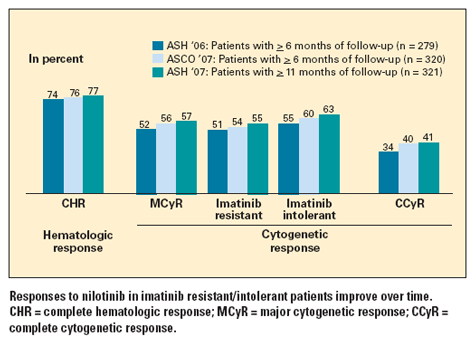Strong nilotinib responses in imatinib-failed CP-CML
This update, of patients with 11 months or greater follow-up, showed a complete hematologic response in 77% of patients receiving nilotinib, with a major cytogenetic response in 57.
This update, of patients with 11 months or greater follow-up, showed a complete hematologic response in 77% of patients receiving nilotinib, with a major cytogenetic response in 57.
ORLANDO-In chronic-phase chronic myelogenous leukemia patients who have failed therapy with imatinib (Gleevec), nilotinib (Tasigna) produces significant activity, with high response and survival rates and excellent tolerability, Hagop Kantarjian, MD, of M.D. Anderson Cancer Center, reported at ASH 2007 (abstract 735).
Results of the study among patients with 6 months or more follow-up were previously reported at ASH 2006 and ASCO 2007; the current report includes patients with 11 months or greater follow-up (n = 321).
The patients all had post-imatinib-failure late CP-CML. Imatinib failure was attributed to resistance in 71% and intolerance in 29%. Median duration of imatinib therapy was 33 months, and median duration of CML was 58 months.
Patients received nilotinib at 400 mg twice daily (with escalation to 600 mg twice daily allowed). Major cytogenetic response rate (MCyR) was the primary endpoint.
Median nilotinib exposure was 394 days and the median dose intensity, at 790 mg/d, was very close to the intended dose of 800 mg/d. Dose interruptions, observed in 54% of patients, occurred in less than 5% of days of exposure (median, 19 days).
A complete hematologic response (CHR) was seen in 77% of patients, with MCyR in 57% of patients: 55% of imatinib-resistant patients and 63% of imatinib-intolerant patients. Complete cytogenetic responses were reported in 41% of patients overall (see Figure).

Median time to MCyR was very rapid, Dr. Kantarjian said, at 2.8 months. Median time to CHR was 1 month. Furthermore, responses were durable, with an estimated cytogenetic response rate of 89% at 12-months and 84% at 18 months. For the same time period, 78% and 64% of patients, respectively, had stable disease. Survival was 95% at 12-months and 91% at 18-months.
Drug-related nonhematological adverse events included rash in 30% (2% grade 3-4); pruritus in 25% (less than 1% grade 3-4); and nausea in 24% (less than 1% grade 3-4). “These did not translate into clinically relevant toxicities requiring intensive supportive care or management,” Dr. Kantarjian said.
Severe myelosuppression (grade 3-4) was observed in 10% to 30% of patients: anemia 10%, neutropenia 30%, thrombocytopenia 28%.
“That’s significantly less than what was observed with imatinib in similar patients-and with some of the other kinase inhibitors,” he said.
Newsletter
Stay up to date on recent advances in the multidisciplinary approach to cancer.